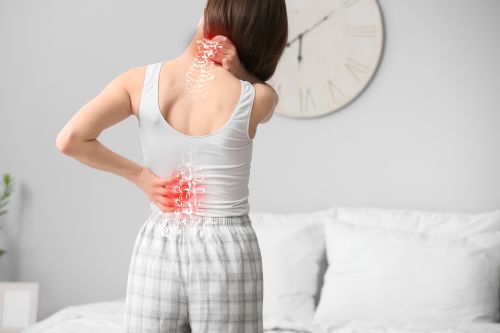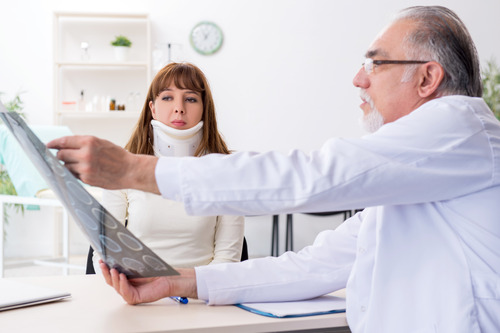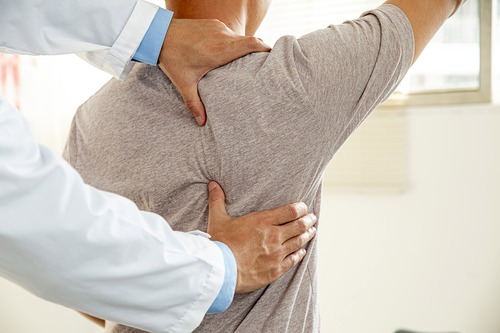Lower back pain is a common and often debilitating symptom following a car accident, impacting daily life and overall well-being. Whether caused by soft tissue injuries, spinal cord damage, or herniated discs, this type of pain can range from mild discomfort to severe, chronic issues. Prompt and effective treatment is crucial to alleviate pain, restore mobility, and prevent long-term complications.
In this blog, we’ll explore common back injuries after a car accident, effective treatment options, and the importance of consulting a car accident doctor for proper diagnosis and recovery.
Understanding Types of Lower Back Pain
Lower back pain after a car accident can stem from various injuries. Understanding these injuries is crucial for effective treatment and recovery. Here, we will explore the most common types of back injuries that can occur due to motor vehicle accidents.
Soft Tissue Injuries
Soft tissue injuries are among the most prevalent types of injuries sustained in car accidents. These injuries affect muscles, tendons, and ligaments. Common symptoms include pain, swelling, and bruising. Muscle strains and sprains are typical examples of soft tissue injuries that can lead to significant discomfort.
In a car accident, the sudden impact can cause these tissues to stretch or tear. For instance, a rear-end collision may cause the head and neck to whip back and forth, resulting in whiplash. This condition often leads to pain in the lower back as well as stiffness. Prompt treatment is essential to manage symptoms and promote healing.
Lumbar Fractures
Lumbar fractures are more severe injuries that involve breaks in the vertebrae of the lower back. These fractures can occur in various forms, such as compression fractures or burst fractures. The impact from a car accident can lead to significant force on the spine, causing these fractures.
A lumbar fracture can have serious implications for the spinal cord and surrounding nerves. Symptoms may include intense pain, numbness, or weakness in the legs. If left untreated, these fractures may lead to long-term complications, including chronic pain or mobility issues. Immediate medical attention is vital to assess the extent of the injury and determine the appropriate treatment.
Herniated Discs
Herniated discs occur when the soft gel-like center of a spinal disc bulges out through a tear in the tougher exterior. This condition can result from the sudden force of a car accident, particularly if the body is jolted or twisted during the impact.
The herniated disc can press on nearby nerves, leading to pain, numbness, or weakness in the back and legs. Individuals may experience sharp pain that radiates down the leg, known as sciatica. Recognizing these symptoms early can help in seeking professional treatment, which may include physical therapy, medication, or even surgery in severe cases.
Recognizing Symptoms of Back Injuries
After a car accident, recognizing the symptoms of back injuries is crucial for effective treatment. Understanding the signs can help you seek appropriate care and prevent long-term complications.
Common Symptoms
Identifying pain symptoms is the first step in addressing back injuries. After an accident, you may experience sharp or dull pain in the lower back. Muscle spasms can also occur, leading to discomfort and limited mobility. It’s important to pay attention to these sensations, as they can indicate underlying issues.
Signs of inflammation and swelling are other key indicators. You might notice redness or warmth in the affected area. Swelling can also lead to stiffness, making it difficult to move freely. If these symptoms arise, taking action quickly is essential for recovery.
Chronic Pain Indicators
Chronic pain can develop from severe injuries sustained in a car accident. If you find that your pain persists for weeks or months, it may be time to seek professional treatment. Long-term effects can include decreased mobility and ongoing discomfort, which can significantly impact your quality of life.
Immediate and Home Remedies for Pain Relief
After a car accident, managing lower back pain is crucial for recovery. Immediate and home remedies can provide relief and support healing. Here are some effective methods to consider.
Rest and Ice Application
Rest is essential for recovery. Taking time off from strenuous activities allows your body to heal. Ice application can significantly reduce inflammation and numb the area, providing quick relief.
- Benefits for reducing inflammation: Applying ice for 15-20 minutes every hour can help minimize swelling. This is especially beneficial during the first 48 hours post-accident.
- Guidelines for effective use: Wrap ice packs in a cloth to protect your skin. Avoid direct contact to prevent frostbite. Alternate between ice and rest to optimize recovery.
Heat Therapy
Heat therapy is another effective method for managing back pain. It can be particularly helpful for chronic pain or muscle tension.
- Role in managing chronic back pain: Heat increases blood flow to the affected area, promoting healing. It relaxes tense muscles and alleviates stiffness.
- Enhancing blood flow and tissue flexibility: Use a heating pad or warm towel for 15-20 minutes. Ensure the heat is comfortable and not too hot to avoid burns.
Over-the-Counter Medications
Over-the-counter (OTC) medications can help manage mild to moderate pain after an accident.
- Options for managing mild pain: Nonsteroidal anti-inflammatory drugs (NSAIDs) like ibuprofen or naproxen can reduce pain and inflammation. Acetaminophen is another option for pain relief.
- Understanding anti-inflammatory medication: Follow the recommended dosage on the label. Be aware of any contraindications or interactions with other medications you may be taking.
Professional Treatment Options
After experiencing lower back pain from a car accident, it’s essential to explore various professional treatment options. Each approach addresses pain and facilitates recovery in distinct ways.
Physical Therapy
Physical therapy plays a crucial role in recovery from back injuries. A skilled physical therapist will assess your specific condition and develop a personalized treatment plan. This plan often includes targeted exercises aimed at improving flexibility, strength, and stability. Techniques such as stretching and strengthening exercises can help restore mobility and reduce pain symptoms. Regular sessions can significantly enhance your recovery process, allowing you to regain function and daily activities.
Chiropractic Treatment
Chiropractic treatment focuses on spinal alignment and overall musculoskeletal health. Chiropractors use manual adjustments to relieve pain and improve function. These adjustments can help alleviate pressure on spinal nerves and restore proper alignment. Many patients report significant pain relief and improved range of motion after chiropractic care. This option is particularly beneficial for those with facet joint injuries or other spinal issues.
Massage Therapy
Massage therapy is another effective treatment for managing lower back pain. Various techniques, such as deep tissue massage, can target tense muscles and promote relaxation. By improving circulation, massage therapy helps reduce inflammation and muscle tension. This approach not only provides immediate pain relief but also contributes to long-term recovery by enhancing overall well-being. Regular sessions can be an integral part of a comprehensive treatment plan.
Advanced Medical Interventions
When dealing with severe lower back pain after a car accident, advanced medical interventions may be necessary. These options can provide significant relief and facilitate recovery for those suffering from serious injuries.
Pain Medication and Management
For individuals experiencing intense pain, prescription pain medication can be a crucial part of the treatment plan. Options might include opioids for short-term relief or nonsteroidal anti-inflammatory drugs (NSAIDs) for ongoing management. It is essential to work closely with a healthcare provider to develop an effective medication management strategy. This approach helps to minimize side effects while ensuring that pain is kept under control.
Steroid and Facet Injections
In cases where inflammation is a significant factor, steroid injections can be beneficial. These injections target the area around the affected facet joints, helping to reduce swelling and interrupt painful nerve firing. Facet joint injuries can lead to chronic discomfort, so these injections often provide temporary but substantial relief, allowing patients to engage more effectively in physical therapy and rehabilitation.
Surgical Options
In some instances, surgery may be the best solution. This is typically considered when other treatments have failed, or when serious injuries pose a risk to the spinal cord or nerves. Surgical procedures can address structural issues, such as herniated discs or spinal fractures, providing a pathway to recovery for those with debilitating pain. It is vital to discuss the potential risks and benefits of surgery with a qualified medical professional to determine the most appropriate course of action.
Contact an Experienced Car Accident Doctor Today!
If you’re struggling with lower back pain after a car accident, don’t let it affect your quality of life any longer. Getting the right diagnosis and treatment is crucial to your recovery and preventing long-term complications. At Hurt 911 Colorado, our dedicated team of professionals is here to provide compassionate, personalized care tailored to your specific needs.
Contact us at 720-414-0000 to schedule an appointment!




